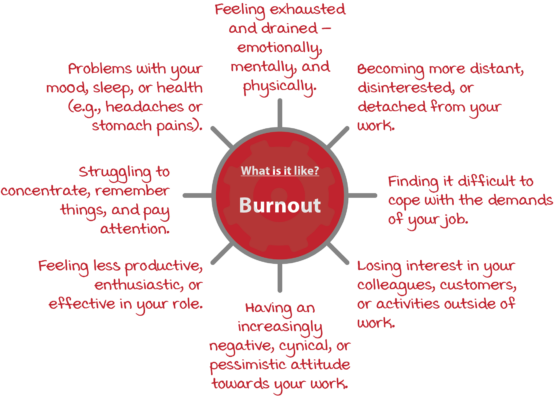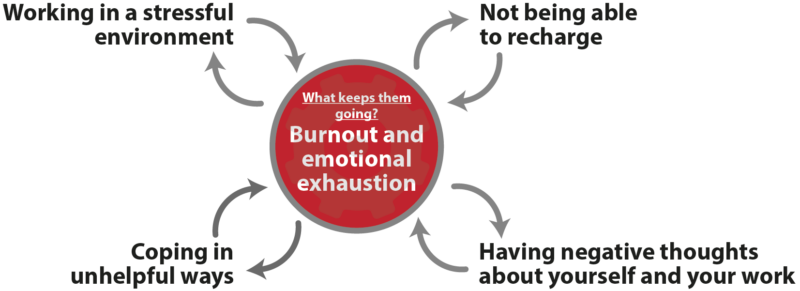Burnout
Most people go through periods where they feel tired or unhappy at work. However, if your job leaves you feeling emotionally exhausted, beyond the point of caring, or unable to function normally, you might be experiencing burnout.
Burnout is a common issue that can affect almost anyone in any job. Research suggests that around 18% of people struggle with high levels of burnout in some countries, and many more are at risk [1]. While burnout is usually a work-related problem, it can arise in other settings, such as sport and education [2, 3].
If it isn’t addressed, burnout can lead to serious difficulties, including problems with your mental and physical health, work, or functioning in daily life. If you’ve been burned out in the past, you might be worried about it coming back. The good news is that burnout can be addressed in lots of different ways, whether working at the level of an individual, a team, or an organization. Cognitive behavioral therapy (CBT) is an effective psychological treatment that can help you overcome this issue.
What is burnout?
‘Burnout’ describes what happens when we feel so depleted by the stresses of work that we struggle to perform. We may feel emotionally drained, unmotivated, and ineffective.
Burnout isn’t something that happens overnight – it’s usually caused by a build-up of stressful things happening inside (and sometimes outside) of work. When you reach the point of burnout, you’ll typically experience some of the following symptoms [4]:

What’s the difference between stress and burnout?
While stress is one of the main causes of burnout, the two are quite different. Most people experience stress as being too ‘full’ of tension, pressure, or anxiety. Burnout, however, feels like you’re extremely ‘empty’ of energy, motivation, or hope.
| When you are stressed… | When you are burned-out… |
| Your emotions are heightened. | Your emotions are dulled. |
| You become more active. | You become more withdrawn. |
| You feel anxious. | You feel low. |
| Your work seems meaningful. | Your work seems meaningless. |
What is it like to struggle with burnout?
Anika’s stresses at work pushed her past the point of caring
I was lucky enough to be offered my ‘dream job’ soon after I qualified. I knew it would be a difficult role, but I was enthusiastic about doing a job that mattered to me.
As I expected, work was tough from the start. I had to help lots of people each day, which meant I had to stay in the office late into the evening, catching up on paperwork. I was so worried about making mistakes that I did everything as thoroughly as possible. What surprised me was how unhappy my team was: they weren’t very welcoming and always complained about their jobs. I tried to keep my distance so the negativity wouldn’t rub off on me.
A few months after I joined the service, my team leader resigned. I was asked to step into his role, which seemed like a great opportunity. Looking back, I can see it was a big mistake. Being a ‘lead’ was very different from the work I’d done before. I still needed to do my usual tasks, but I also had to manage everybody else in the team – I was completely new to that. My co-workers became hostile towards me because they didn’t want to be managed by someone so ‘new’, and every day I felt like I was under attack. What made it worse was how little support I was given. As a senior team member, I didn’t receive any kind of supervision or mentoring. I felt like a pilot flying through a fog, desperately trying to do a good job but with no idea of what direction to go in.
As time went on, work started to take over my life. My responsibilities increased, so I had to work harder and longer to keep up. I stopped taking breaks and spent my evenings preparing for the day. I also started drinking after work, which probably made my already poor sleep even worse. When the weekend arrived, all I wanted to do was rest and cut myself off from everything else.
Slowly, my stress turned to exhaustion. I felt like I couldn’t keep up anymore, as if the job had defeated me. It’s hard to explain how tired and empty I felt. My attitude towards work also changed. I used to feel passionate about helping people, but by this point, I was past the point of caring. Nothing I did seemed to matter. The problems with my team got worse as well. I avoided interacting with them as much as possible, and whenever I did, I behaved dismissively. I didn’t like the person I’d become.
When I spoke to my GP about my recurrent stomach aches, the idea of ‘burnout’ came up. I thought I might be depressed or just not suited to the job, but my doctor explained that it was a common problem in professions like mine. I hope I can find my enthusiasm for work again.
Am I burned-out?
It’s sometimes difficult to notice burnout, particularly if you’ve been struggling with it for a long time or don’t pay much attention to your own needs. It can also look and feel like depression (although depression is a different type of problem and requires a different kind of treatment).
Answering the questions below can give you an idea of whether it is worth arranging a professional assessment.
| Does your work leave you feeling exhausted? | Yes | No |
| Have you lost the energy and enthusiasm you had for your job? | Yes | No |
| Do you ever appear uncaring, disinterested, or insensitive at work? | Yes | No |
| Have you started caring less about your clients or colleagues? | Yes | No |
| Do you think that nothing you do at work makes a difference? | Yes | No |
| Do you feel frustrated, disappointed, or disillusioned with your job? | Yes | No |
| Are you neglecting yourself (e.g., not taking time to rest, eat, or exercise)? | Yes | No |
| Have your family, friends, or colleagues noticed a change in your character? | Yes | No |
If you answered ‘yes’ to most of these questions, you may be struggling with burnout. You might find it helpful to speak to your family doctor or a mental health professional about how you are feeling.
What causes burnout?
Burnout doesn’t have a single cause, but there are some things that make you more likely to experience it:
- Your job. Work environments play a big role in burnout. If you have a large workload, long hours, or little control over your job, you may be at greater risk. Burnout has also been linked to having conflicting or unclear roles at work, feeling unsupported, and receiving a lack of feedback from others [5,6]. Professionals who work in ‘people-focused’ jobs (e.g., teachers and medical professionals) are particularly at risk of severe burnout, but burnout is relevant to all types of work [7].
- Your personal life. Problems outside of work can sometimes increase the risk of burnout. These include relationship difficulties, financial worries, caring for a family member, and conflicts between work and family commitments [8].
- Your personality.Some personality traits appear to be related to burnout. If you are the type of person who finds it difficult to cope with stressful events, you doubt your worth or competence, or if you tend to experience more negative emotions and fewer positive emotions, you may be at greater risk of burnout [9].
- Your beliefs. Some research suggests that your beliefs about yourself and your work can affect burnout. For example, one study found that beliefs about needing to meet high personal standards (e.g., perfectionism) were linked to burnout in trainee therapists [10]. Other studies have found a similar link between perfectionism and burnout [11].
- Genetic factors. Research evidence suggests that there may be genes that make you likely to develop emotional problems in general, and the same is probably true of burnout. However, your experiences in and around work are likely to play a bigger role.
What keeps burnout going?
Burnout can be looked at through different lenses. It can be seen as an individual problem, an organizational problem, or a problem in our society. Often, all these perspectives are relevant. This means that there are several ways people with burnout can be helped.
Research studies have shown that cognitive behavioral therapy is one effective treatment for burnout [12,13]. CBT therapists work a bit like firefighters: while the fire is burning, they’re not so interested in what caused it, but are more focused on what is keeping it going (and what they can do to put it out). Working out what keeps a problem going means that they can address it by tackling the cycles that maintain it.
CBT models of burnout suggest that several things keep burnout going once it starts [14,15,16]. These include:
Treatments for burnout
Treatments for burnout can include working with individuals, teams, and organizations where burnout is an issue. Organizational treatments involve working with groups of people (such as departments or entire businesses) and might focus on things like workload management, teamwork, and peer support [13]. Individual treatments for burnout usually involve psychological therapy.
Psychological treatments for burnout
Cognitive behavioral therapy (CBT) is an effective treatment for people who are experiencing burnout [14,15]. It can be provided as a one-to-one therapy, in groups, or alongside other types of help like career counseling or working with employers. There is also some evidence that Acceptance and Commitment Therapy (ACT) may have the potential to reduce burnout [16].
CBT is a popular form of talking therapy. Unlike some other therapies, it is quite structured. After talking things through so your therapist understands your problem, you can expect to set some goals so you both know what you are working towards. At the start of most sessions, you and your therapist will set an agenda so you can both agree on what that session will focus on. It’s best to seek a therapist with experience in working with burnout.
Some of the ‘ingredients’ of effective CBT for burnout can include [14,15]:
- Assessing and monitoring the symptoms of burnout you’re struggling with.
- Developing a shared understanding of what keeps your burnout – this is usually drawn out as a ‘formulation’.
- Learning about the causes of stress and burnout.
- Addressing lifestyle factors that might be playing a role (e.g., sleep difficulties, exercise, alcohol consumption).
- Tackling negative thoughts and beliefs that contribute to burnout.
- Developing new work-related skills (e.g., communication skills, time-management, or managing conflicts with others.)
- Engaging in leisure activities that you enjoy and that help you recuperate.
- Developing ways to relax.
- Creating a plan that helps you maintain your progress and avoid setbacks in future.
Medical treatments for burnout
Medical treatments are not usually used to treat burnout. However, they are sometimes used to address the problems that sometimes accompany it, such as depression.
References
- Lindblom, K. M., Linton, S. J., Fedeli, C., & Bryngelsson, I. L. (2006). Burnout in the working population: relations to psychosocial work factors. International Journal of Behavioral Medicine, 13, 51-59. https://doi.org/10.1207/s15327558ijbm1301_7.
- Goodger, K., Gorely, T., Lavallee, D., & Harwood, C. (2007). Burnout in sport: A systematic review. Sport Psychologist, 21, 127-151.
- Madigan, D. J., & Curran, T. (2021). Does burnout affect academic achievement? A meta-analysis of over 100,000 students. Educational Psychology Review, 33, 387-405. https://doi.org/10.1007/s10648-020-09533-1.
- Maslach, C. (2003). Burnout: The cost of caring. Malor Books.
- Aronsson, G., Theorell, T., Grape, T., Hammarström, A., Hogstedt, C., Marteinsdottir, I., Skoog, I., Traskman-Bendz, L., & Hall, C. (2017). A systematic review including meta-analysis of work environment and burnout symptoms. BMC Public Health, 17, 1-13. https://doi.org/10.1186/s12889-017-4153-7.
- O’Connor, K., Neff, D. M., & Pitman, S. (2018). Burnout in mental health professionals: A systematic review and meta-analysis of prevalence and determinants. European Psychiatry, 53, 74-99. https://doi.org/10.1016/j.eurpsy.2018.06.003.
- Schaufeli, W., & Buunk, B. P. (2003). Burnout: An overview of 25 years of research and theorizing. In M. J. Schabracq, J. A. M. Winnubst, & C. L. Cooper (Eds.), Handbook of work and health psychology(pp. 383 – 425). Wiley.
- Schaufeli, W. B., Bakker, A. B., Hoogduin, K., Schaap, C., & Kladler, A. (2001). On the clinical validity of the Maslach Burnout Inventory and the Burnout Measure. Psychology and Health, 16, 565-582. https://doi.org/10.1080/08870440108405527.
- Hasselberg, K., Jonsdottir, I. H., Ellbin, S., & Skagert, K. (2014). Self-reported stressors among patients with exhaustion disorder: an exploratory study of patient records. BMC Psychiatry, 14, 1-10.
- Alarcon, G., Eschleman, K. J., & Bowling, N. A. (2009). Relationships between personality variables and burnout: A meta-analysis. Work and Stress, 23, 244-263. https://doi.org/10.1080/02678370903282600.
- Kaeding, A., Sougleris, C., Reid, C., van Vreeswijk, M. F., Hayes, C., Dorrian, J., & Simpson, S. (2017). Professional burnout, early maladaptive schemas, and physical health in clinical and counselling psychology trainees. Journal of Clinical Psychology, 73, 1782-1796. https://doi.org/10.1002/jclp.22485.
- Hill, A. P., & Curran, T. (2016). Multidimensional perfectionism and burnout: A meta-analysis. Personality and Social Psychology Review, 20, 269-288. https://doi.org/10.1177/1088868315596286.
- De Simone, S., Vargas, M., & Servillo, G. (2021). Organizational strategies to reduce physician burnout: a systematic review and meta-analysis. Aging Clinical and Experimental Research, 33, 883-894. https://doi.org/10.1007/s40520-019-01368-3
- Ahola, K., Toppinen-Tanner, S., & Seppänen, J. (2017). Interventions to alleviate burnout symptoms and to support return to work among employees with burnout: Systematic review and meta-analysis. Burnout Research, 4, 1-11. https://doi.org/10.1016/j.burn.2017.02.001.
- Perski, O., Grossi, G., Perski, A., & Niemi, M. (2017). A systematic review and meta‐analysis of tertiary interventions in clinical burnout. Scandinavian Journal of Psychology, 58, 551561.https://doi.org/10.1111/sjop.12398.
- Towey-Swift, K. D., Lauvrud, C., & Whittington, R. (2022). Acceptance and commitment therapy (ACT) for professional staff burnout: a systematic review and narrative synthesis of controlled trials. Journal of Mental Health, 1-13. https://doi.org/10.1080/09638237.2021.2022628
About this article
This article was written by Dr Matthew Whalley and Dr Matthew Pugh, both clinical psychologists. It was last reviewed on 2022/08/19.



